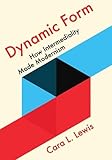Dynamic Form : How Intermediality Made Modernism / Cara L. Lewis.
Material type: TextPublisher: Ithaca, NY : Cornell University Press, [2020]Copyright date: ©2021Description: 1 online resource (330 p.) : 28 b&w halftonesContent type:
TextPublisher: Ithaca, NY : Cornell University Press, [2020]Copyright date: ©2021Description: 1 online resource (330 p.) : 28 b&w halftonesContent type: - 9781501749193
- Amerian literature -- 20th century -- History and criticism
- Art and literature -- Great Britain -- History -- 20th century
- Art and literature -- United States -- History -- 20th century
- English literature -- 20th century -- History and criticism
- Formalism (Art) -- History
- Formalism (Literary analysis) -- History
- Literary form -- History -- 20th century
- Modernism (Art) -- Great Britain
- Modernism (Art) -- United States
- Modernism (Literature) -- Great Britain
- Modernism (Literature) -- United States
- Art History
- Literary Studies
- Photography
- Photography / History
- modernism, visual arts, media, literary form, art in literature
- 820.9/0092 23
- PR478.M6 L49 2020
- PR478.M6 L49 2021
- online - DeGruyter
| Item type | Current library | Call number | URL | Status | Notes | Barcode | |
|---|---|---|---|---|---|---|---|
 eBook
eBook
|
Biblioteca "Angelicum" Pont. Univ. S.Tommaso d'Aquino Nuvola online | online - DeGruyter (Browse shelf(Opens below)) | Online access | Not for loan (Accesso limitato) | Accesso per gli utenti autorizzati / Access for authorized users | (dgr)9781501749193 |
Frontmatter -- Contents -- List of Illustrations -- Acknowledgments -- Introduction: Reformulating Modernism -- 1. Plastic Form: Henry James’s Sculptural Aesthetics and Reading in the Round -- 2. Mortal Form: Still Life and Virginia Woolf ’s Other Elegiac Shapes -- 3. Protean Form: Erotic Abstraction and Ardent Futurity in the Poetry of Mina Loy -- 4. Bad Formalism: Evelyn Waugh’s Film Fictions and the Work of Art in the Age of Cinemechanics -- 5. Surface Forms: Photography and Gertrude Stein’s Contact History of Modernism -- Epilogue: The Consolations of Form -- Notes -- Bibliography -- Index
restricted access online access with authorization star
http://purl.org/coar/access_right/c_16ec
Dynamic Form traces how intermedial experiments shape modernist texts from 1900 to 1950. Considering literature alongside painting, sculpture, photography, and film, Cara Lewis examines how these arts inflect narrative movement, contribute to plot events, and configure poetry and memoir. As forms and formal theories cross from one artistic realm to another and back again, modernism shows its obsession with form—and even at times becomes a formalism itself—but as Lewis writes, that form is far more dynamic than we have given it credit for. Form fulfills such various functions that we cannot characterize it as a mere container for content or matter, nor can we consign it to ignominy opposite historicism or political commitment.As a structure or scheme that enables action, form in modernism can be plastic, protean, or even fragile, and works by Henry James, Virginia Woolf, Mina Loy, Evelyn Waugh, and Gertrude Stein demonstrate the range of form's operations. Revising three major formal paradigms—spatial form, pure form, and formlessness—and recasting the history of modernist form, this book proposes an understanding of form as a verbal category, as a kind of doing. Dynamic Form thus opens new possibilities for conversation between modernist studies and formalist studies and simultaneously promotes a capacious rethinking of the convergence between literary modernism and creative work in other media.
Mode of access: Internet via World Wide Web.
In English.
Description based on online resource; title from PDF title page (publisher's Web site, viewed 01. Dez 2022)


